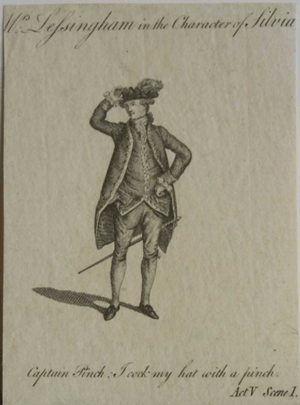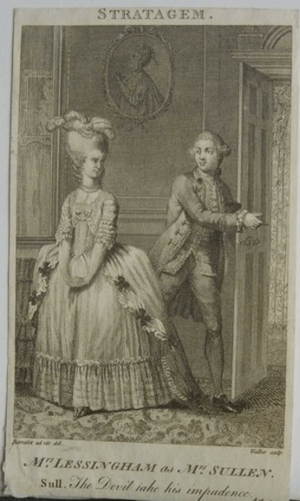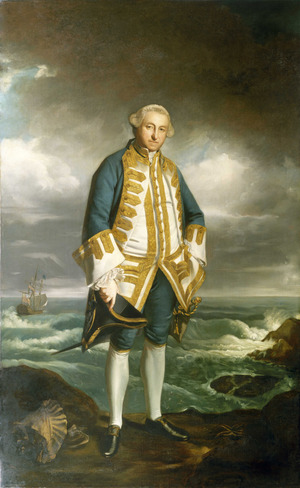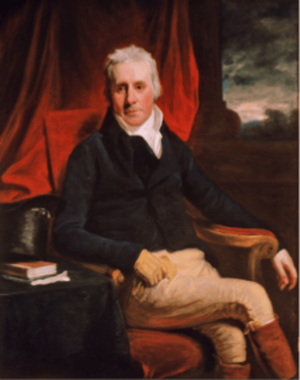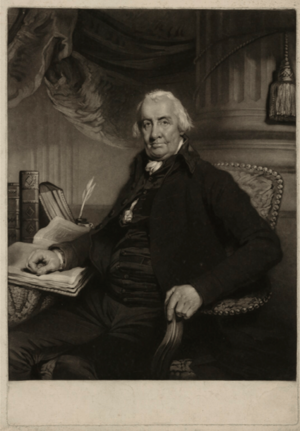Jane Lessingham facts for kids
Jane Lessingham (born Jane Hemet, 1738 or 1739 – March 13, 1783) was a famous stage actress. She was also known by her married name, Jane Stott. Jane acted from 1756 to 1782, mostly at the Theatre Royal, Covent Garden in London. People knew her for her beauty and her talent in comedy plays.
Quick facts for kids
Jane Lessingham
|
|
|---|---|
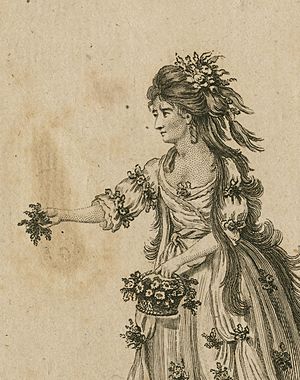
Lessingham as the character Ophelia in a production of Hamlet in 1775.
|
|
| Born | Jane Hemet, 1738 or 1739 |
| Died | 13 March 1783 |
| Burial place | Hampstead Churchyard, London, United Kingdom |
| Occupation | Stage Actress |
| Years active | 1756- 1782 |
| Spouse(s) | John Stott (m. 1753- div. 1765) |
| Partner(s) | Samuel Derrick (1765)
Thomas Harris (1767? -1771) Admiral Boscawen Sir William Addington (1775) ... |
| Children | 5, Amelia Stott, Thomas Charlton Harris, Charles Harris (b. 1 June 1769), Edwin Harris (b. 2 February 1771) and William Frederick |
Jane Lessingham first appeared on stage in 1756. She played Desdemona in a play called Othello at the Theatre Royal, Covent Garden. She started using the stage name 'Lessingham' in March 1762. Her first role with this new name was Silvia in George Farquhar's play The Recruiting Officer.
In 1768, Lessingham was part of a public disagreement between theatre managers Thomas Harris and George Colman. People at the time said that Lessingham's strong desires were a big reason for the fight.
Jane Lessingham passed away on March 13, 1783. She was buried in Hampstead Churchyard. She left her money and property to Thomas Harris, to help care for their four sons.
Acting Career
The actor Tate Wilkinson wrote in his personal writings that Jane Lessingham was a student of John Rich in 1756. Rich was the person who started the Theatre Royal, Covent Garden. He helped her begin her acting career.
Lessingham's first performance was as Desdemona in Othello on November 18, 1756. At that time, she used the name Mrs. Stott. She did not act again for a while. In 1762, she returned to the stage and started using the name 'Lessingham'. Her first role was Silvia in George Farquhar's play The Recruiting Officer, where she dressed as a man.
Between 1763 and 1767, Lessingham had some success. She worked at Smock Alley Theatre in Dublin, Drury Lane in London, and other smaller theatres. These included theatres in Bath, Bristol, and Richmond.
When Lessingham returned to the Theatre Royal, her career quickly became very successful. She stayed at this theatre for the rest of her acting life. However, her success was often talked about, especially during a public argument in 1768. This argument was between Harris and another theatre manager, George Colman.
A historian named John Genest wrote that Lessingham was "only a second, or rather a third rate actress." He thought that only personal reasons, not her acting skill, could have made Harris support her so much. The theatre critic John Roach said that Harris and Colman first argued because Harris insisted on a private dressing room for Lessingham.
Another argument happened because Harris and Lessingham wanted her to play Imogene in Cymbeline. Colman had already given that role to another actress, Mrs. Yates. Colman wrote publicly that giving the part to Lessingham would be "very unfair to Mrs. Yates and disrespectful to the public." Even so, Lessingham got the role.
In September, Lessingham refused a smaller role as Nerissa in The Merchant of Venice. She wrote a letter saying she wanted an "equal share of good and bad" parts. The public argument between Harris and Colman became very popular. People often made fun of it in cartoons.
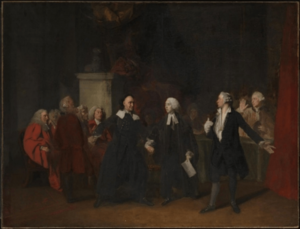
Lessingham continued to act at the Theatre Royal until 1782, the year before she died. She was paid £4 a week, which went up to £7 a week during her last five seasons. In 1776, she played Mrs. Sullen in another of Farquhar's plays, The Beaux Stratagem.
Her performances in sad roles were not very popular. James Stewart called her a "boring actress." However, he said she was "okay as Jacintha" in The Suspicious Husband and "other parts in boy's clothes." Another critic, Francis Gentleman, said she was "tasteless." Her last role was Jacintha in Benjamin Hoadley's The Suspicious Husband in 1782.
Plays She Performed In
| Year | Title | Role | Venue |
|---|---|---|---|
| 1756 | Othello | Desdemona | Unknown |
| 1762 | The Recruiting Officer | Silvia | Theatre Royal, Covent Garden |
| 1762 | Jane Shore | Jane Shore | Unknown |
| 1765 | The Guardian. A Farce in Two Acts | Clackit | Theatre Royal, Covent Garden or Drury Lane |
| 1768 | Cymbeline | Imogene | Theatre Royal, Covent Garden |
| 1768 | The Merchant of Venice | Nerissa | Theatre Royal, Covent Garden |
| 1772 | Hamlet | Ophelia | Theatre Royal, Covent Garden |
| 1776 | The Beaux Stratagem | Mrs Sullen | Theatre Royal, Covent Garden |
| 1777 | The Inconstant | Oriana | Theatre Royal, Covent Garden |
| 1777 | The City Wives Confederacy | Clarissa | Theatre Royal, Covent Garden |
| 1779 | She Would and She Would Not | Flora | Theatre Royal, Covent Garden |
| 1782 | The Suspicious Husband | Jacintha | Theatre Royal, Covent Garden |
| Unknown | The Deuce is Him | Madame Florival | Theatre Royal, Covent Garden |
| Unknown | The Tragical History of King Richard III | Lady Anne | Theatre Royal, Drury Lane |
| Unknown | The refusal; or the ladies' philosophy | Sophronia | Theatre Royal, Covent Garden |
| Unknown | The Country Lasses | Flora | Theatre Royal, Covent Garden |
Personal Life
In 1753, Jane Lessingham married a naval commander named John Stott. They were married at St. Paul's, Covent Garden.
Lessingham later had a relationship with Samuel Derrick. Derrick helped her get ready to become an actress. They lived together for a time. Later, Lessingham ended the relationship.
Lessingham also had a relationship with Admiral Boscawen. This was confirmed by Captain William Hanger in his writings from 1772. He wrote that the Admiral supported Mrs. Lessingham very well.
Around the 1760s, Lessingham became involved with Thomas Harris. They had four sons together: Thomas Charlton Harris, Charles Harris (born June 1, 1769), Edwin Harris (born February 2, 1771), and William Fredrick.
Harris used his connections to help two of their sons get jobs in India in 1813. Charles Harris became the first judge of a court in India. Thomas Charlton Harris became a high-ranking officer in the army in the Prune district. Harris also helped Edwin start a career in the navy.
In 1775, Lessingham started a relationship with Sir William Addington. That same year, he gave her land in Gibbet Hill, Hampstead. She hired someone to build a house there. In 1776, Lessingham built Heath Lodge in Hampstead Heath. It was a beautiful house designed by James Wyatt. It was described as "a small, but elegant villa" with lovely gardens.
Death
Jane Lessingham died on March 13, 1783. She was buried four days later at Hampstead Churchyard. Her gravestone had her maiden name, Jane Hemet. In her will, Lessingham left her property to Thomas Harris. This was to be held in trust for their four sons: Thomas, Charles, Edwin, and William Frederick.
In 1802, her son William Frederick replaced her gravestone. The new stone read: "MRS JANE LESSINGHAM, late of the Theatre Royal, Covent Garden Obt 13 March 1783, [sic] aet 44. Her grateful and affectionate son WILLIAM FREDERICK, caused this tomb to be repaired, anno 1802, as a last token of respect to her memory."
Images for kids


